34072 257 Squadron – Restoration
Purchase from Barry
In 1984 the group who were working on Port Line decided that it would be a good idea to purchase one of the remaining 'Unrebuilt' Bulleid Pacifics still at Barry scrapyard. This decision was made at a time when Port Line was a kit of parts with many years work still to be done. However it turned out to be a far sighted move as by the time Port Line was finished in 1988 the few Bulleid Pacifics remaining at Barry were in a virtually unrestorable state. In November 1984, 34072 was duly delivered to Blunsdon where it remained until we moved into Swindon Works.
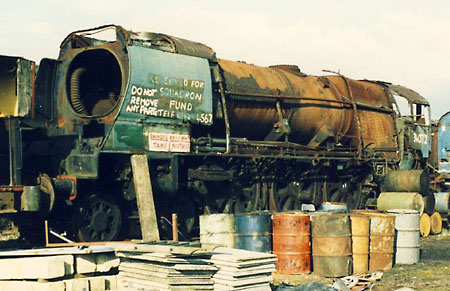 |
257 Squadron awaits attention after its move from Barry |
Swindon Works and Tarmac
In autumn 1987 we were given the use of the former Swindon Works weighbridge to complete the restoration of Port Line. During this period some initial work was done in stripping 257 Squadron ready for a boiler lift. We were able to use the crane that was hired to re-instate Port Line's boiler to lift the boiler from 257 Squadron.
A significant development occurred in 1988 when the site was visited by a group of Tarmac directors. They were shown round the weighbridge and the virtually complete Port Line when one of the group asked how we were possibly going to restore the rusting wreck in the corner of the yard. Our engineer, Willie Bath, explained that Port Line had been in much the same condition when purchased and he also went on to explain the significance of the name, 257 Squadron. A chance remark that it would be most appropriate if the engine were restored by 15th September 1990, the 50th anniversary of the Battle of Britain, resulted in a fax a few days later requesting details of how much would be needed to meet this target.
Once figures had been worked out, Tarmac offered an interest free loan repayable over five years once the locomotive had been completed. This was an offer that seemed too good to refuse although there was no doubt as to the enormous task ahead, particularly as the five year restoration of Port Line was the fastest Barry restoration at that time.
Frustrations and Difficulties
The Tarmac loan enabled us to employ three people to work full-time on the locomotive with volunteers assisting at weekends. The restoration commenced in the Weighbridge at Swindon and although there were still some extensive machining facilities on the site we were not allowed to use them which meant that a lot of the work had to be sub-contracted out. (We were not professional railwaymen!). At one stage we were asked to vacate the weighbridge and move into 19 Shop in the old works. No sooner had we settled in there than we were asked to move back again to the Weighbridge as 19 Shop was to be used by the National Railway Museum for an exhibition. Both moves took the best part of two weeks to complete.
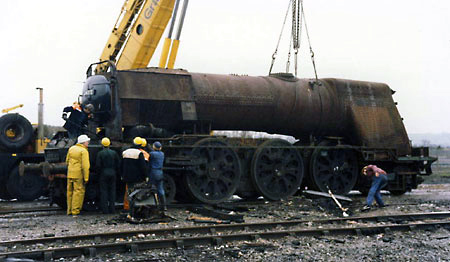 |
The boiler is lifted from the frames in 1988 |
We were invited by Network South-East to take part in a Battle of Britain celebration at Folkestone in September 1990. The intention had been to operate a shuttle service between Folkestone Harbour and Central but this was rejected by BR on the grounds that the locomotive was too heavy and an appearance and naming ceremony at Folkestone station was arranged instead. (A few years later the heavier Taw Valley operated on the Folkestone Harbour branch but that's another story.)
By early 1990 we were well behind schedule not only with the actual restoration but also on the delivery of parts and there did not seem much hope of meeting our deadline in September. The spring of 1990 saw much frenetic activity and the locomotive rapidly began to take shape. One notable occasion in April 1990 saw the team working through the night in order to prepare for the locomotive's first steam test the following day in the presence of the BR boiler inspectors. Arrangements were made to borrow a number of parts which were not going to be ready in time including a tender and by the end of August the locomotive was virtually complete.
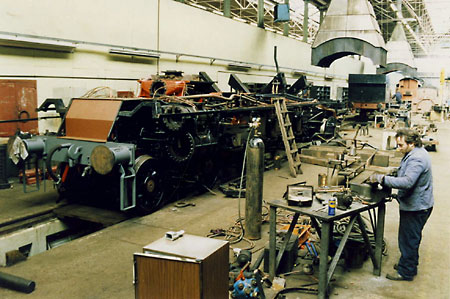 |
Work progressing inside Swindon Works in 1989 |
If the problems of early 1990 weren't enough one final blow was yet to come. Arrangements were made to move the locomotive to Derby for weighing followed by a loaded test run to Sheffield. After this the locomotive would then move to Folkestone. However, late on the Friday afternoon before the move to Derby, the Western Region Civil Engineer had other ideas and would not allow the locomotive out of Swindon on the grounds that it was out of gauge. Many organisations would have probably thrown in the towel at this point but after a number of frantic telephone calls we were able to arrange for a transporter to take the locomotive to Folkestone the following Wednesday.
Even the move by transporter was not without difficulties. The locomotive was required to wait on the hard shoulder of the M25 as there was an accident ahead. Unfortunately the passing motorists who slowed down to look at the engine managed to pile into one another and it took the best part of two hours to sort out the 20 vehicles involved.
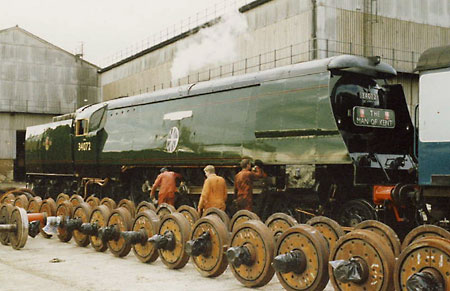 |
257 Squadron outside Ashford Works |
257 Squadron finally arrived at Cheriton, the site of the channel tunnel terminal, at about midnight on the Thursday and was left on the transporter until the following morning. In order to speed things up, the boiler was lit up while still on the transporter before being winched off onto the rails and towed to Ashford.
Celebrations at Folkestone
The test run took place on the Friday afternoon with a trip down the main line to Folkestone and Dover albeit with a electro-diesel pilot. There were no problems despite the fact that the locomotive had only previously been tested on 75 yards of track at Swindon. The crew decided to 'see what she would do' on the return to Ashford and with the diesel pilot very much a passenger 257 Squadron reached a speed which unfortunately we have not been able to repeat.
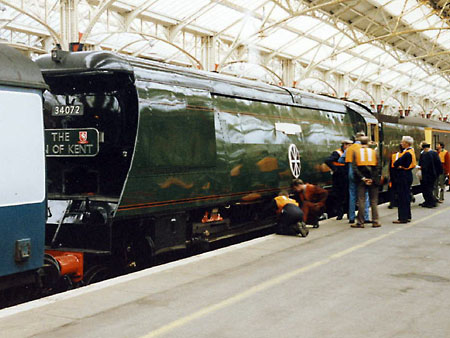 |
257 Squadron at Dover Marine with nameplates covered prior to renaming |
Saturday, September 8th produced another first as 257 Squadron steamed into Folkestone without a diesel pilot looking immaculate. The re-naming ceremony was carried out by Air Commodore Peter Brothers, a former 257 Squadron pilot and the event was attended by a number of other former Battle of Britain pilots for whom, no doubt, the highlight was the flying display as a lone Spitfire made a number of passes over the station.
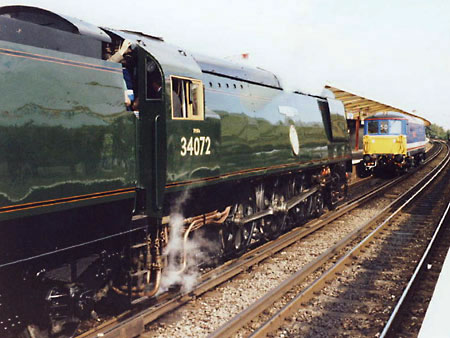 |
An immaculate 257 Squadron at Folkestone |
Later that afternoon, 257 Squadron hauled a short train to Dover and then back to Ashford, completing a memorable and triumphant day.
